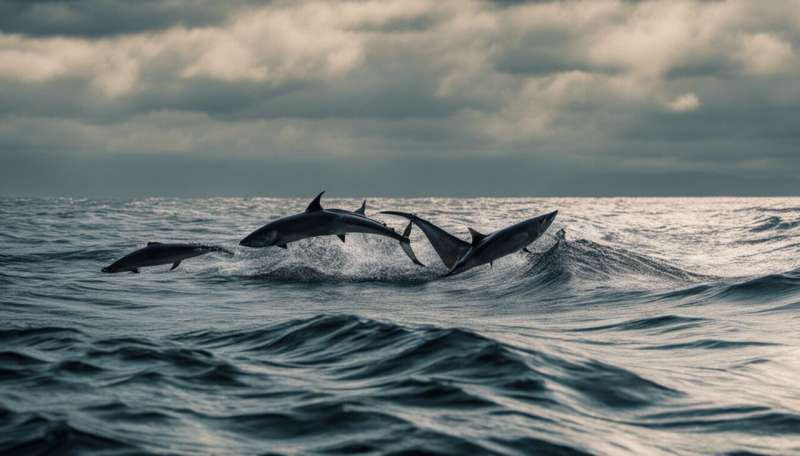Scientist uses Fukushima radiation to reveal swimming secrets of Pacific bluefin tuna

(Phys.org) —Trace radiation from the Fukushima nuclear disaster is showing up in Pacific bluefin tuna. By measuring that radiation, scientists are gaining valuable insight about the fish's early migratory habits.
Last May, scientists reported that 15 Pacific bluefin tuna caught in California in the months after the disaster at Japan's Fukushima Dai-ichi nuclear power plant in 2011 contained trace amounts of radiation. It was the first evidence of migrating animals transporting radioactive materials across the ocean, and the researchers suggested it could provide a means for tracking the fish's annual migrations.
Now, nearly two years after the plant discharged radioactive materials into the ocean, follow-up research led by a biology PhD candidate at Stanford finds that young Pacific bluefin tuna are still arriving in California carrying two of Fukushima's signature radioisotopes, cesium-134 and cesium-137.
The work supports the idea that the Fukushima radioisotopes can be used to reliably determine the previously unknown trans-oceanic movements of juvenile Pacific bluefin tuna. This information could be used to prevent tuna from being overfished.
Pacific bluefin tuna are born several miles off the shores of Japan and surrounding countries. They spend their first year foraging in those waters, and then either remain in the western Pacific or migrate eastward to California. Although the movements of adult tuna have been revealed through electronic tagging programs, electronic tagging of juvenile bluefin in Japan has been difficult, and so certain details of this early-life migration remain unknown.
Daniel Madigan, who works in the Micheli Lab at Stanford's Hopkins Marine Station in Monterey, Calif., worked with collaborators at the National Oceanic and Atmospheric Administration and Stony Brook University to sample 50 Pacific bluefin tuna that were between 1 and 4 years old.
Born near Japan
Because the fish are born near Japan, the smallest fish were certain to have swum in Japanese waters only in the year following the Fukushima accident. The presence of cesium in these fish would support the claim that they are still carrying radiation from Fukushima eastward, and that this measure can be used to trace bluefin migrations.
Analyses performed at Nicholas Fisher's lab at Stony Brook University in New York revealed that every one of the smallest fish contained low but detectable cesium-134 levels, making it clear which fish had recently spent time swimming near Japan.
(Madigan stressed that the Fukushima radiation found in bluefin tuna is significantly lower than naturally occurring radioactive isotopes normally found in the fish.)
The measurements might also shed light on how long ago the fish left the cesium-contaminated waters near Japan. Madigan showed that measuring the ratio of two of the isotopes discharged by Fukushima, cesium-134 and cesium-137, could indicate how much time had passed since a fish left Japan. This approach could make it possible to tell which fish have swum from Japan to California and then back Japan to breed before returning to California.
"We plan to look for this tracer in hundreds of samples of Pacific bluefin tuna to get a better idea of their retrospective movements," Madigan said. "It's not that easy to tell what a fish did in the past, but this gives us a forensic tool."
Valuable fish
Pacific bluefin tuna are a valuable part of the global commercial fishing industry, and particularly in the world of sushi: In January, a buyer at a Tokyo auction paid a record $1.76 million for a 500-pound tuna, to be sliced into fine sushi. And although the species isn't endangered, its worldwide numbers are down 96 percent from unfished levels, according to a December report.
"They haven't been described as a troubled species until about two months ago, but they've been shown to be heavily overfished," Madigan said. "Understanding the proportions of different sizes of fish that come east and at what point they return to Japan can help fisheries on both sides of the ocean manage stocks."
The technique should also prove useful for tracking migrations of other species, Madigan said, including albacore, sea turtles, sharks and seabirds. Cesium-137 has a half-life of 30 years, so Madigan expects that measurable amounts will be present in tuna, and other species, for at least the next several years, which will provide ample time to reveal these animals' migratory habits.
The study was published in the journal Environmental Science & Technology.
More information: pubs.acs.org/doi/abs/10.1021/es4002423
Journal information: Environmental Science & Technology
Provided by Stanford University


















